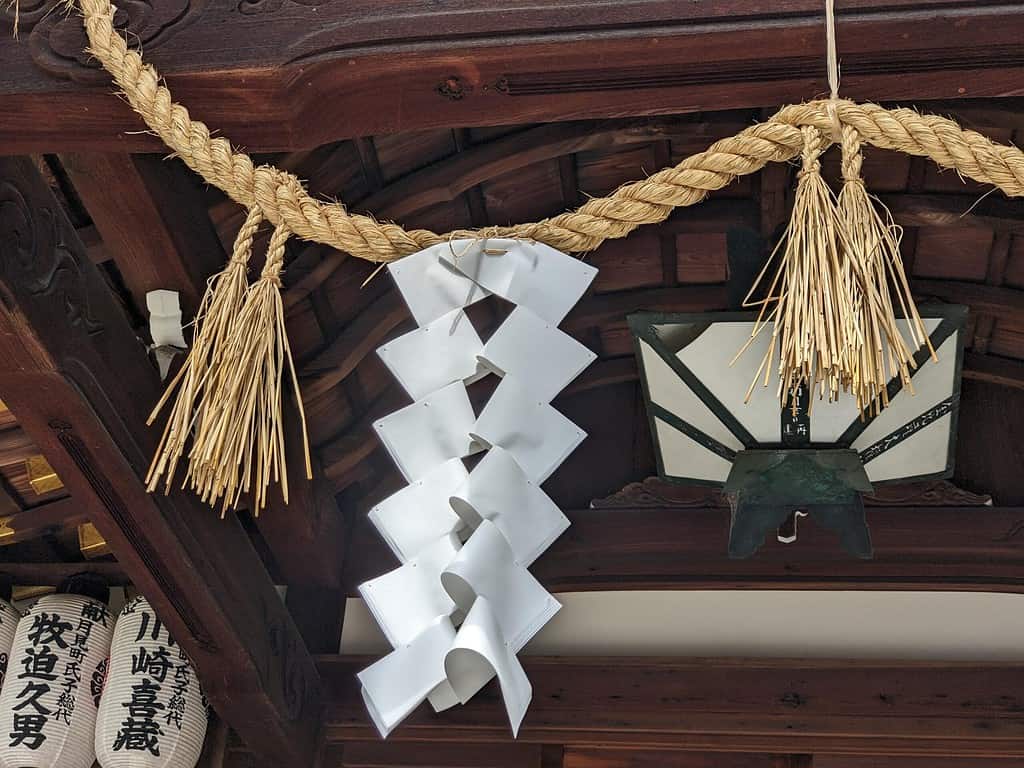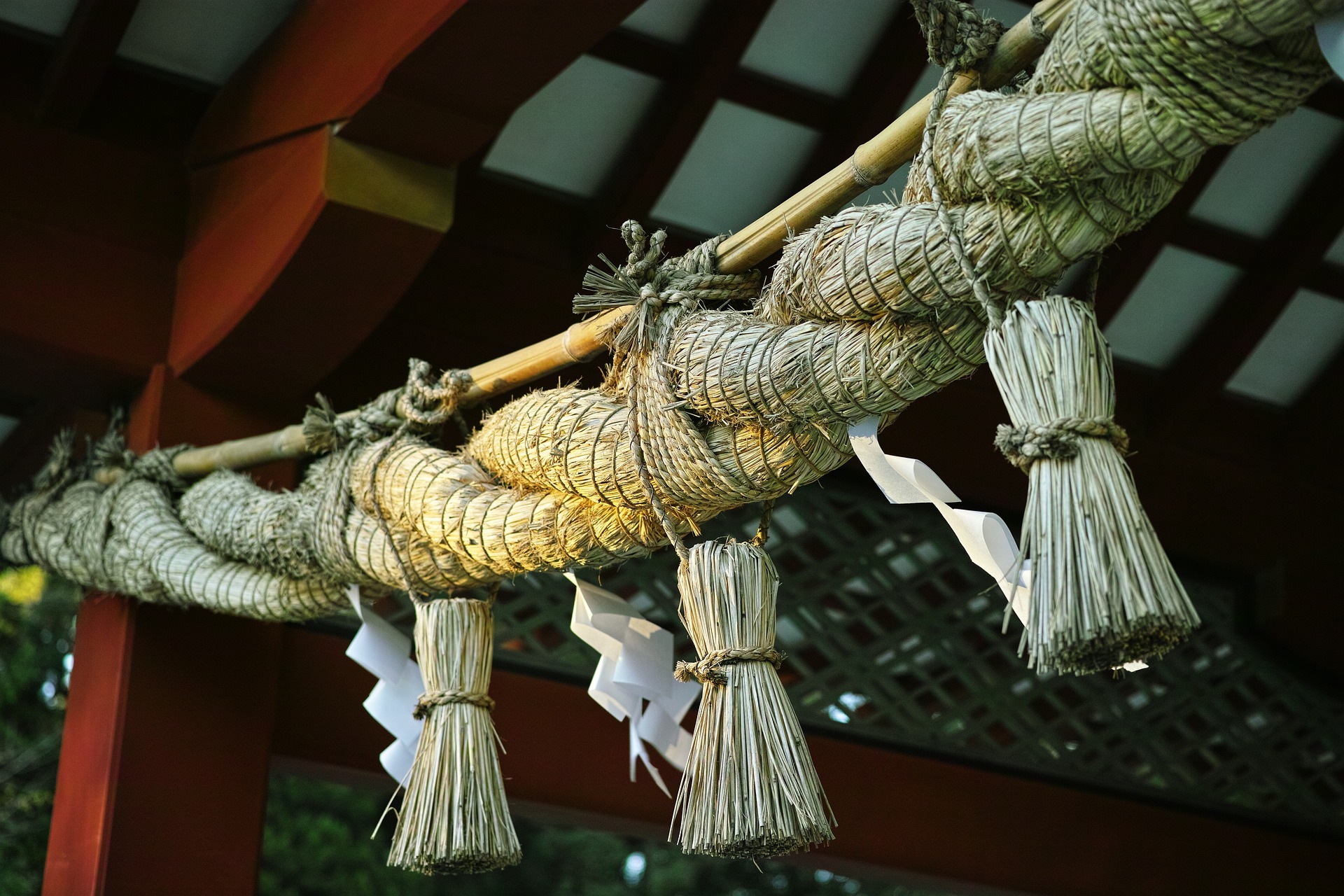The Sacred Rope of Japan
What is a shimenawa rope? What does shimenawa mean? What is shimenawa made of? We will answer those questions along with providing a bit of history and and culture in this comprehensive blog post about this sacred rope of Japan.
Shimenawa (標縄), meaning “enclosing rope” in Japanese, is a traditional rope made of rice straw or hemp, used in Shinto rituals to mark a sacred space or object. This article will explore the history of shimenawa, its cultural significance, and how it is used today in Japan.


Planning a trip to Japan?
History of Shimenawa
Shimenawa has a long history in Japan, dating back to the Jomon period (14,000-300 BCE), where it was used as a tool for hunting and fishing. During the Nara period (710-794), shimenawa became associated with Shintoism, the indigenous religion of Japan, and was used to mark sacred spaces and objects. The use of shimenawa in Shinto rituals was further developed during the Heian period (794-1185), where it became an integral part of the religion.

During the Edo period (1603-1868), shimenawa became more elaborate and decorative, with the addition of paper streamers called shide. It was also during this time that shimenawa became associated with the New Year’s festival, where it is used to mark the entrance to a shrine or home, and is believed to ward off evil spirits and bring good luck.

Cultural Significance of Shimenawa
What does Shimenawa represent? Shimenawa holds great cultural significance in Japan, and is considered to be a symbol of purification and protection. It is used to mark sacred spaces and objects, such as trees, rocks, and shrines, and is believed to separate the sacred from the profane.
Why do Japanese tie shimenawa ropes around trees or rocks? Shimenawa is also used to mark the boundary between the spirit world and the human world. In Shintoism, it is believed that spirits, or kami, inhabit all things, including trees, rocks, and waterfalls. By marking these objects with shimenawa, it is believed that the spirits will be contained within them, and will not harm or interfere with humans.
In addition to its use in Shintoism, shimenawa is also used in other cultural practices in Japan. For example, sumo wrestlers wear a braided rope called a tsuna, which is similar in appearance to shimenawa, around their waists during tournaments. The tsuna is believed to bring the wrestler good luck and protect them from injury.
Types of Shimenawa
Shimenawa comes in various sizes and styles, depending on its purpose and the occasion. There are different types of shimenawa, each with its own unique characteristics. For smaller applications, such as household shrines or decorative purposes, thinner and more lightweight shimenawa are commonly used. These may feature simple braided designs and are often adorned with shide paper streamers. On the other hand, larger and more elaborate shimenawa can be seen in grand Shinto shrines and during important festivals. These impressive shimenawa ropes can be several meters long and have a thicker, more intricate braiding pattern. They are often decorated with additional elements such as sacred symbols, bells, or natural materials like pine branches and citrus fruits. The diversity in size and style of shimenawa ensures that they can be tailored to fit the specific requirements and aesthetics of different ceremonial or decorative contexts.

How Shimenawa is Used Today
Shimenawa is still used today in Japan, both in Shinto rituals and in everyday life. Here are some examples of how shimenawa is used today:
Final Thoughts
Shimenawa holds a significant cultural and religious importance in Japan. It is a symbol of purification and protection, and is used to mark sacred spaces and objects, as well as to separate the spirit world from the human world.
Shimenawa has a long history in Japan, dating back to the Jomon period, and has evolved over time to become more elaborate and decorative, with the addition of shide paper streamers during the Edo period.
Today, shimenawa is still used in Shinto rituals, as well as in everyday life in Japan. It is used in agricultural festivals, sumo wrestling, and festivals and parades as a decorative element.
As Japan continues to embrace modernity, it is heartening to see that shimenawa and other traditional practices are still being passed down from generation to generation, preserving the country’s unique cultural heritage. Whether used in a Shinto shrine or in a sumo wrestling tournament, shimenawa continues to be a powerful symbol of Japan’s spiritual and cultural identity.
Disclaimer: If you use the link on this page to purchase travel insurance, we will receive a fee from Freely, a brand of Cover-More Insurance Services Pty Limited ABN 95 003 114 145 (AFSL 241713) (Cover- More). We do not act for Cover-More or Freely. The information provided is only on the availability of Freely products. We do not give advice & the information provided is not intended to give an opinion or recommendation regarding the product. For information on how to contact Cover-More or Freely refer to the PDS, FSG & TMD which can be found on the Freely website.




2 thoughts on “Shimenawa – The Sacred Rope of Japan”